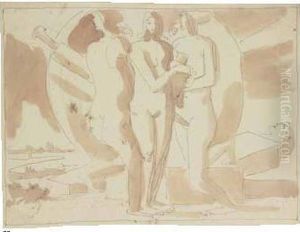Fortunato Duranti Paintings
Fortunato Duranti was an Italian artist known for his eccentric and diverse body of work, encompassing drawings, paintings, and illustrations. Born in Montefortino, Marche, Italy, in 1787, Duranti lived through a period marked by political upheaval and artistic transformation in Europe. From a young age, he displayed a keen interest in the arts, inspired by the rich cultural heritage of Italy and the burgeoning Romantic movement that swept through Europe in the late 18th and early 19th centuries.
Duranti's artistic journey began in the local church, where he was first exposed to religious art and the works of earlier Italian masters. This early exposure had a profound impact on his artistic development, instilling in him a deep appreciation for the spiritual and emotional power of art. Despite his passion, Duranti's path was not straightforward. He faced familial opposition to his artistic pursuits, which were deemed impractical and financially unsustainable. Nevertheless, Duranti persisted, eventually leaving his small town to study art in Rome.
In Rome, Duranti was exposed to a wide array of artistic styles and influences. He was particularly drawn to the works of the Old Masters, as well as contemporary artists who were pushing the boundaries of traditional art forms. Duranti's own style began to evolve, characterized by a unique blend of classical and romantic elements. His works often depicted historical and mythical scenes, imbued with a sense of drama and emotional intensity that was characteristic of the Romantic era.
Despite his talent and the originality of his work, Duranti struggled to gain recognition during his lifetime. He lived in relative obscurity, supported by a small but devoted group of patrons. His eccentricity and refusal to conform to the prevailing artistic trends of his time may have contributed to his marginalization within the art world.
After his death in Montefortino in 1863, Duranti's work fell into obscurity until the late 20th century, when art historians and collectors began to reassess his contribution to the Italian Romantic movement. Today, Duranti is celebrated for his unique artistic voice and his ability to capture the complexity of the human experience through his work. His legacy is preserved in the collections of various Italian museums, where his drawings and paintings offer insight into the rich tapestry of 19th-century Italian art.















